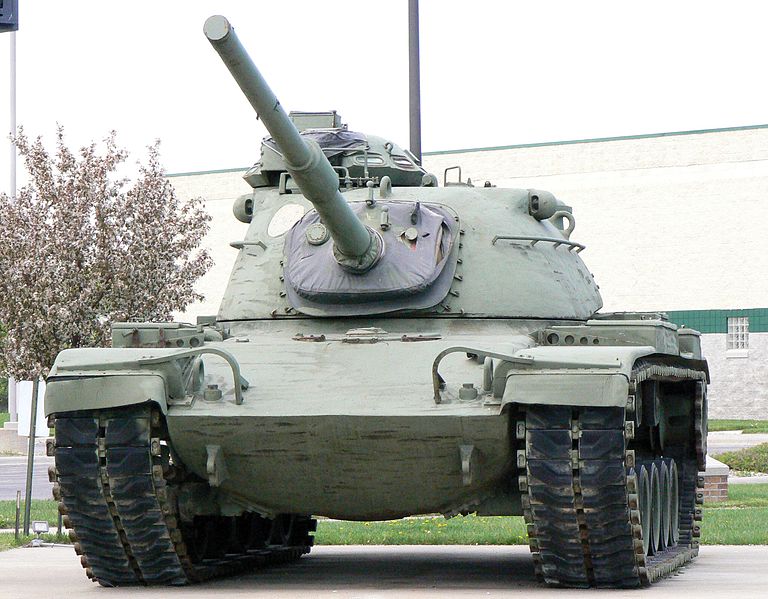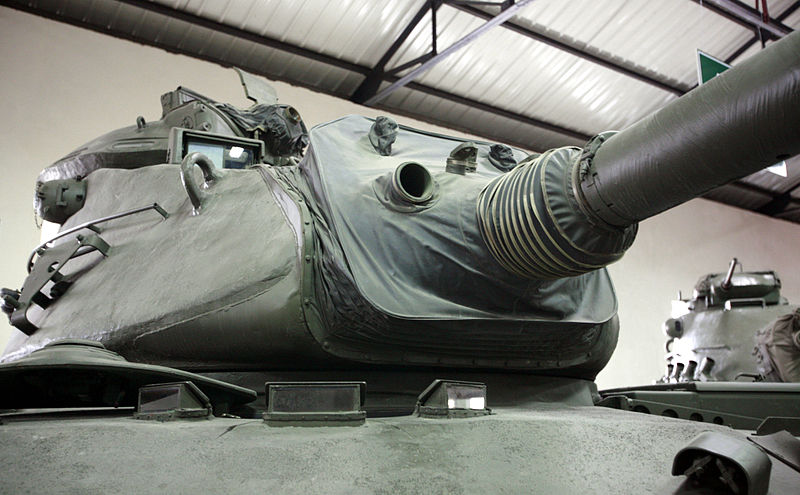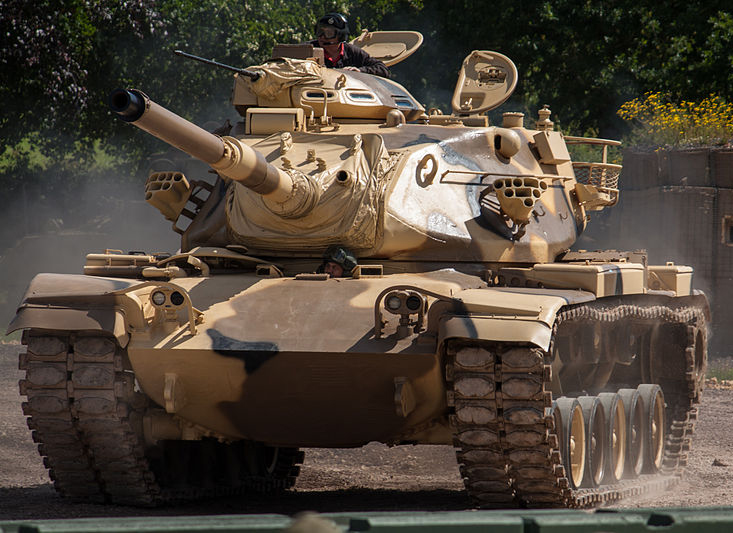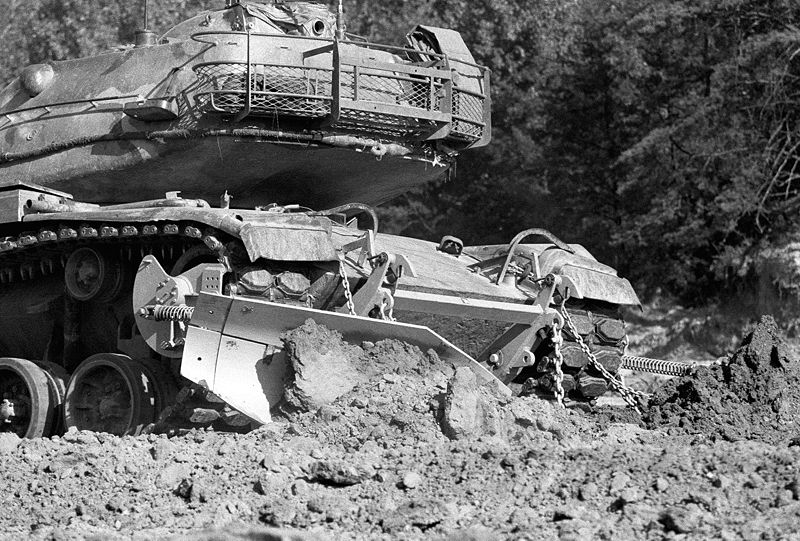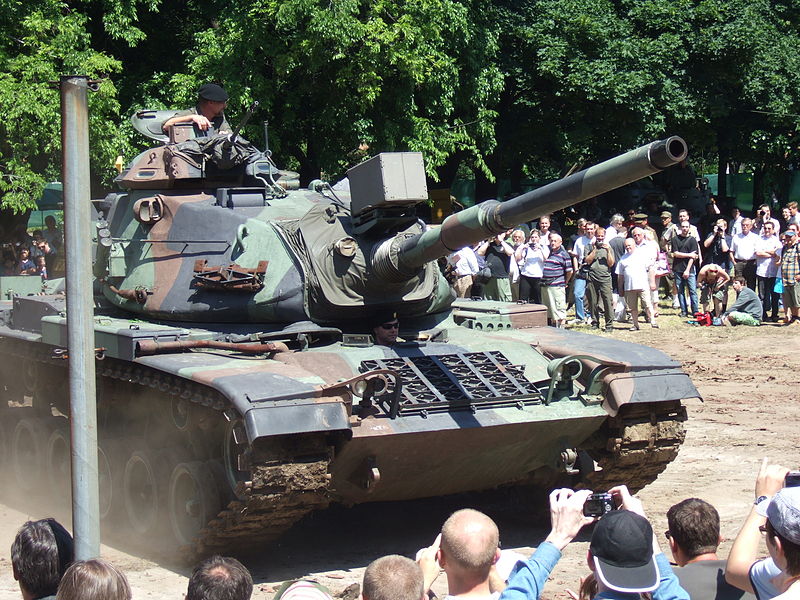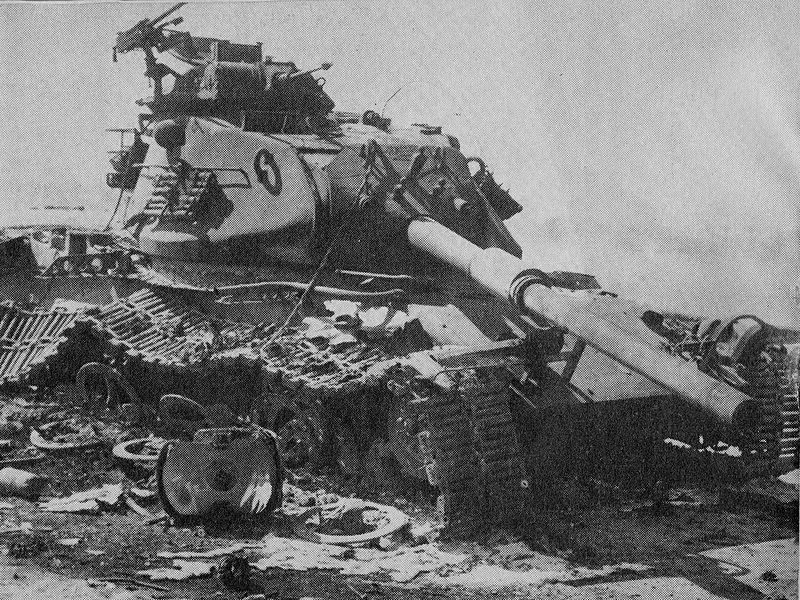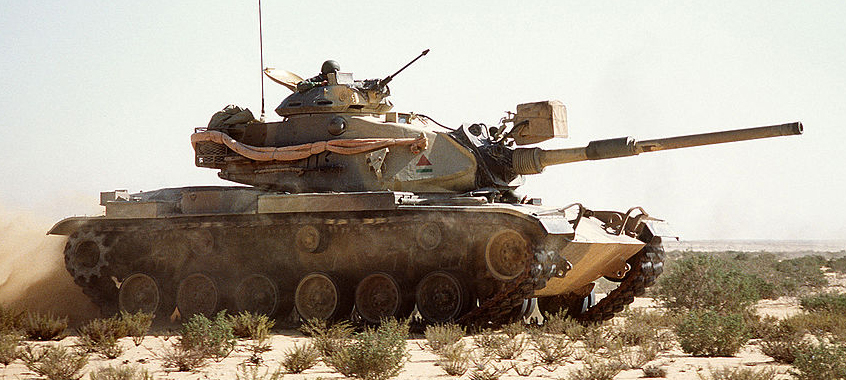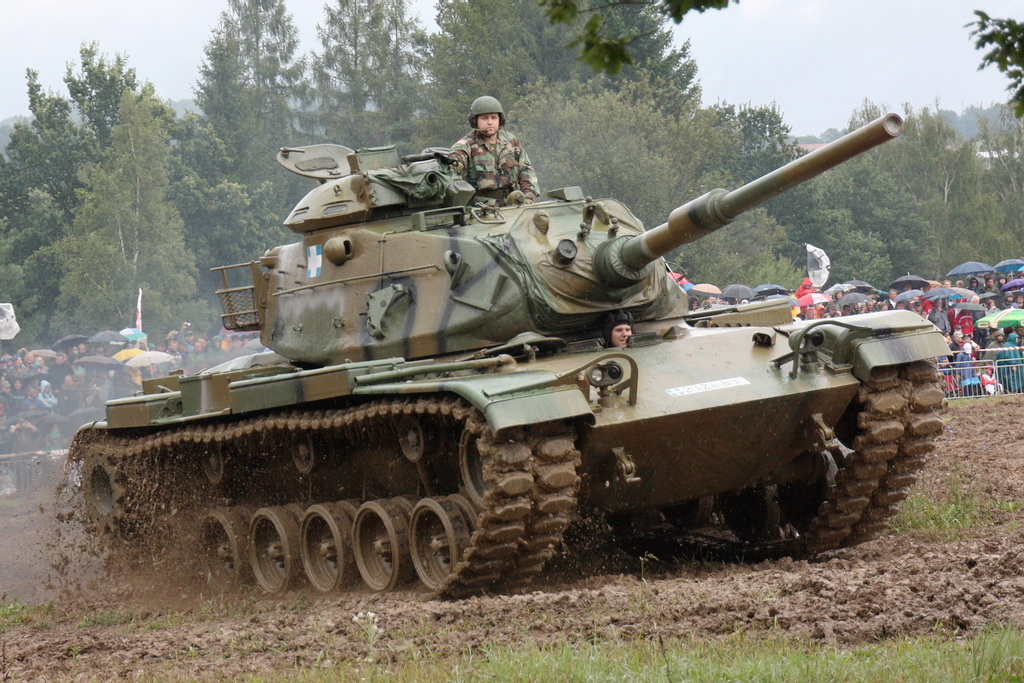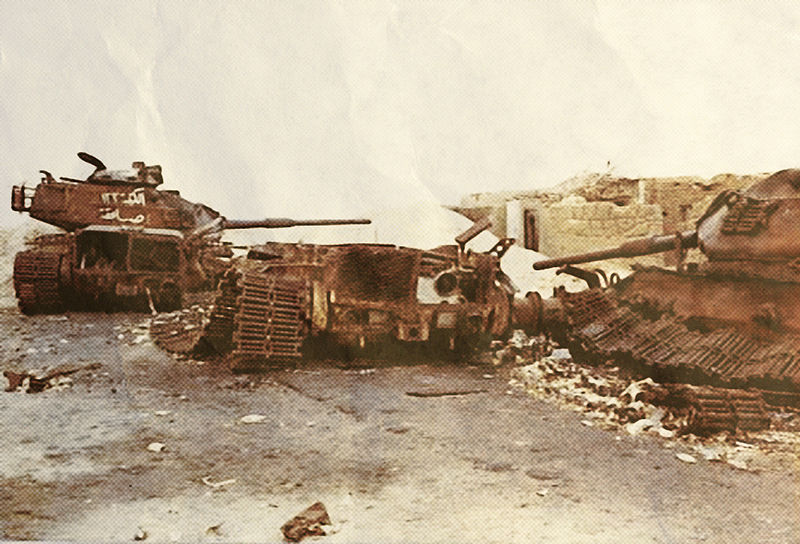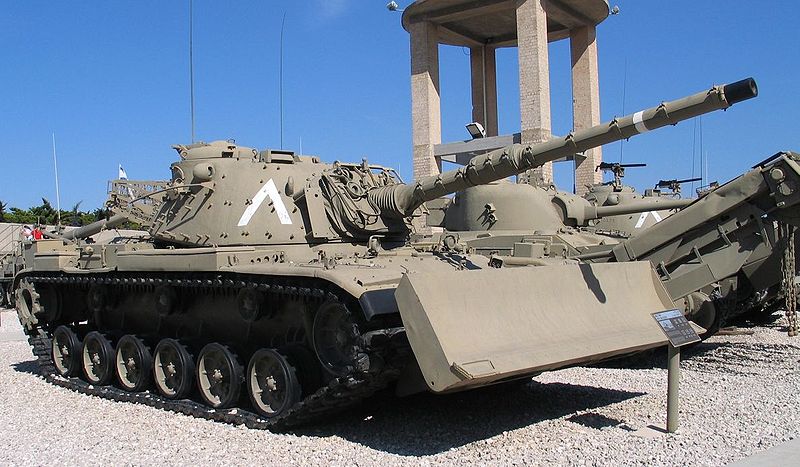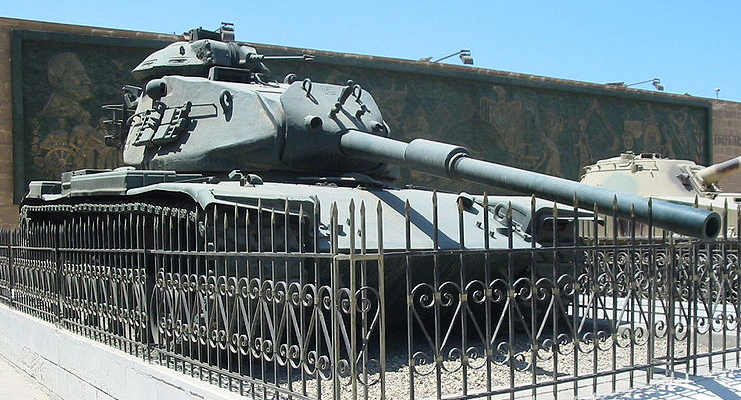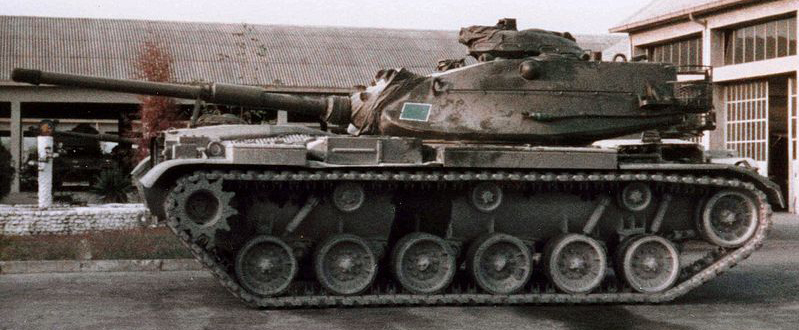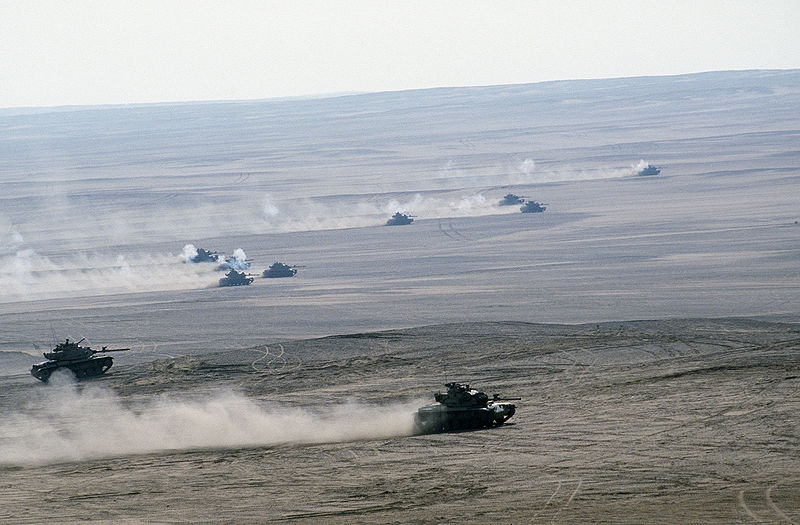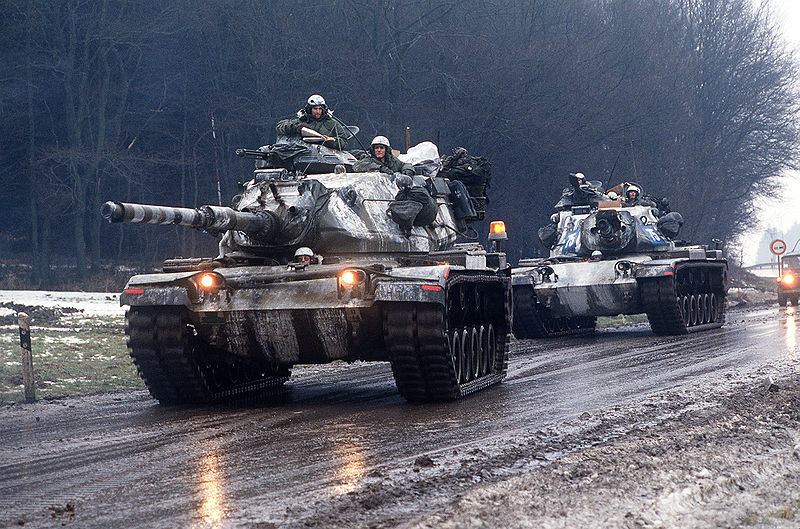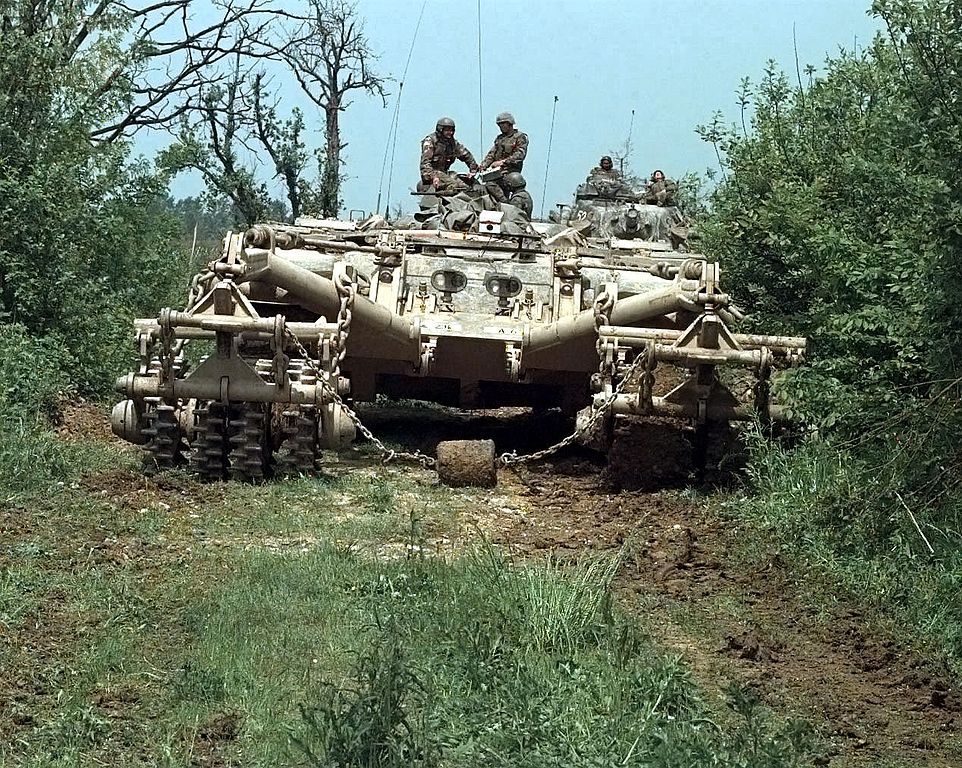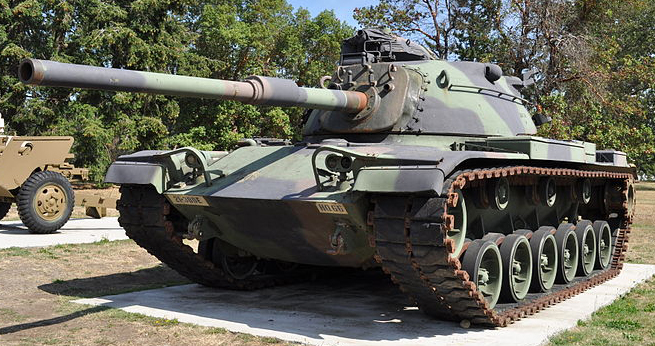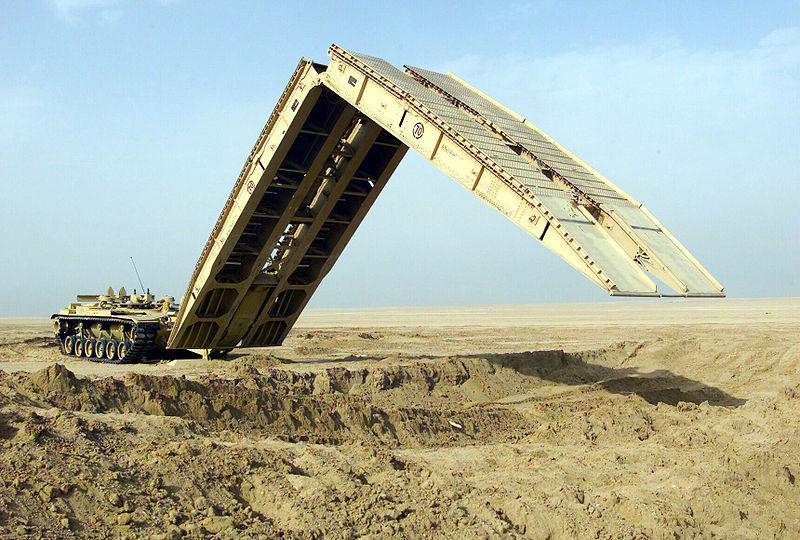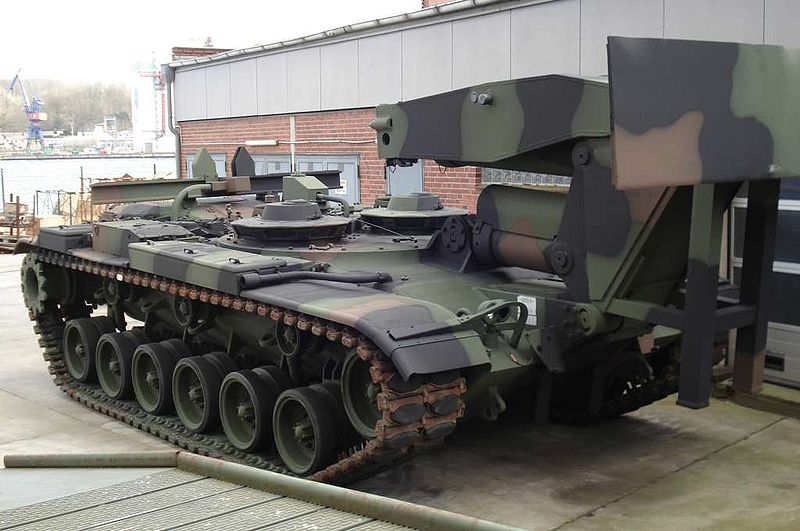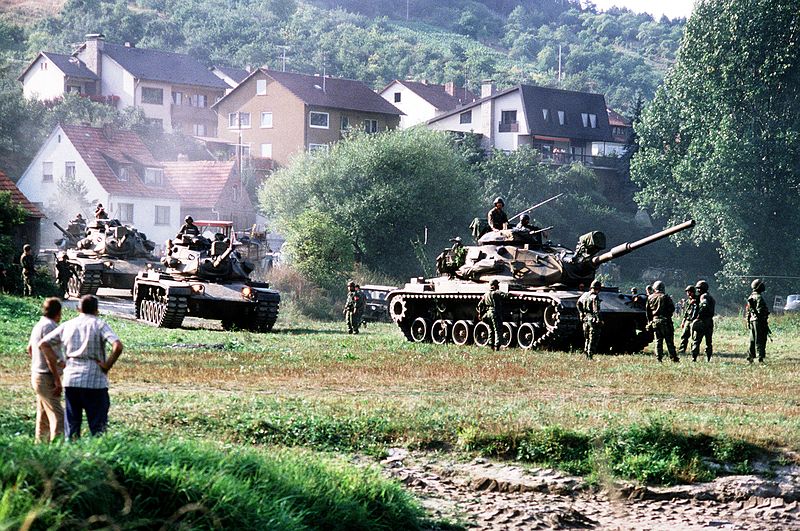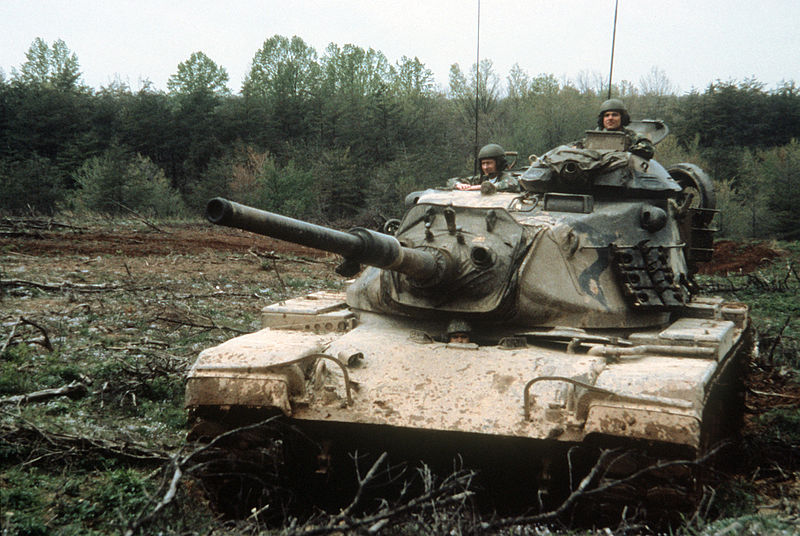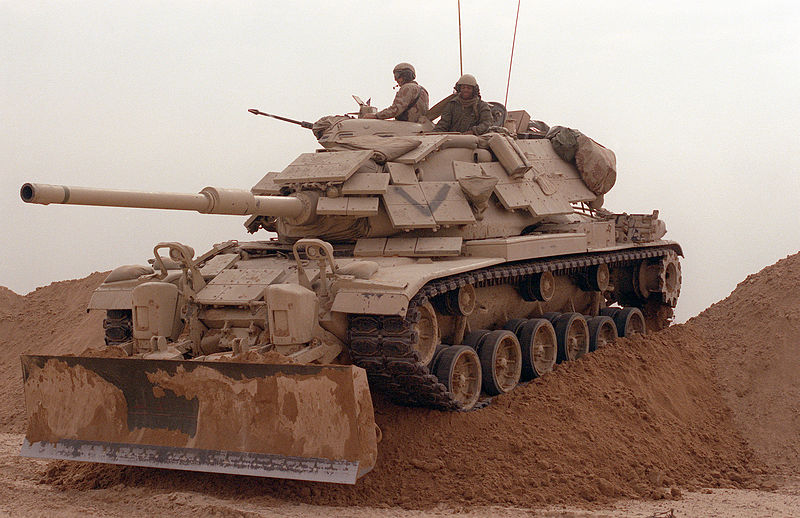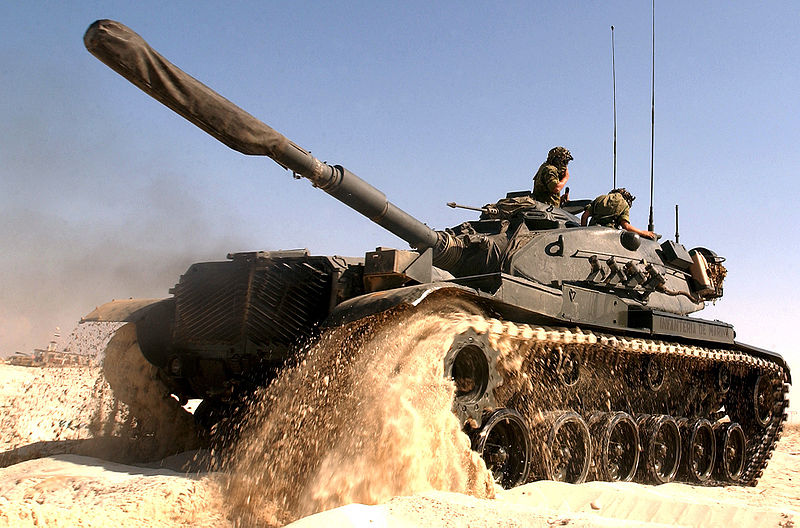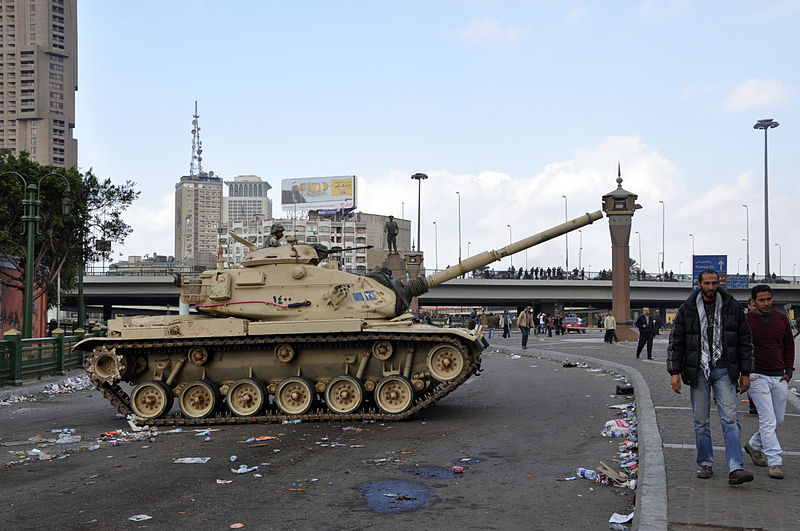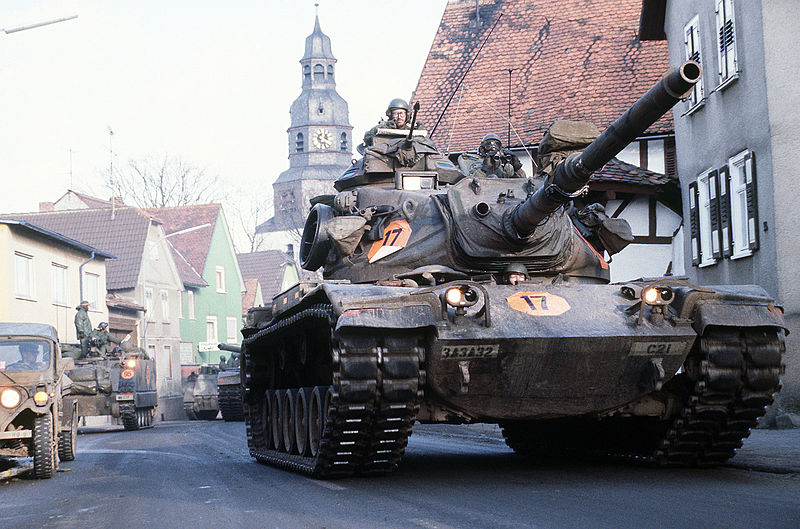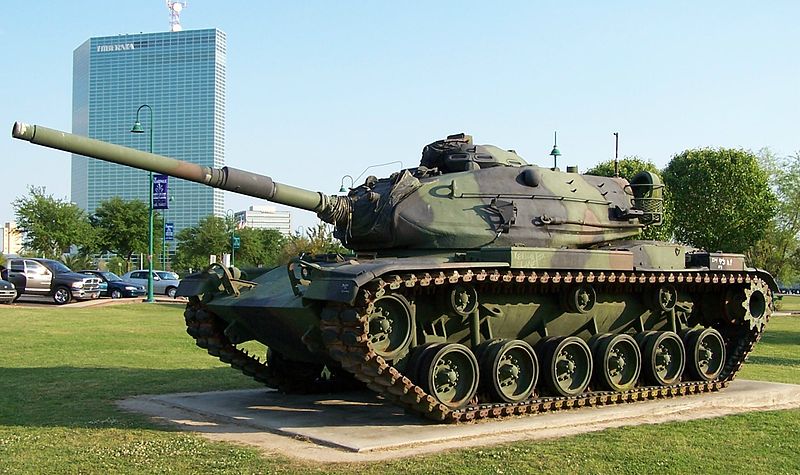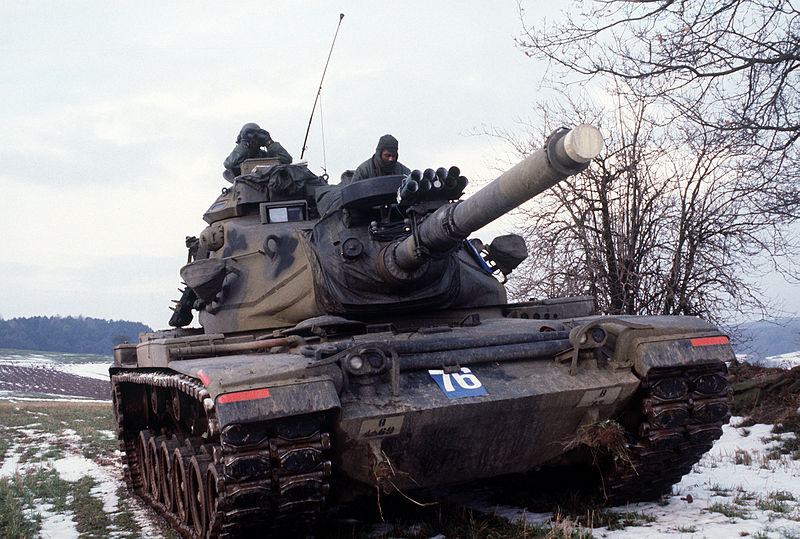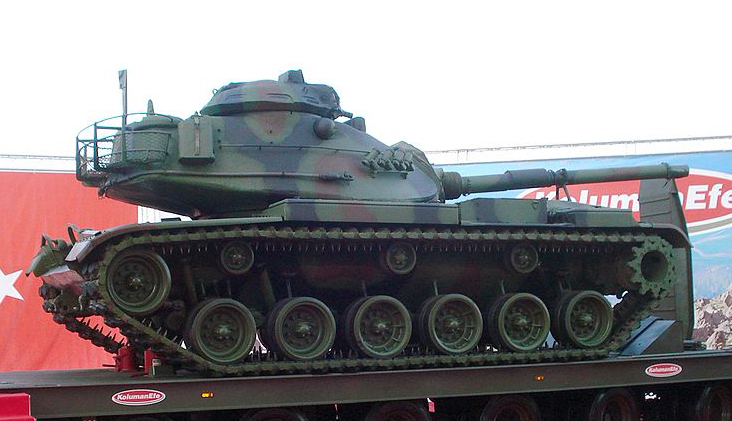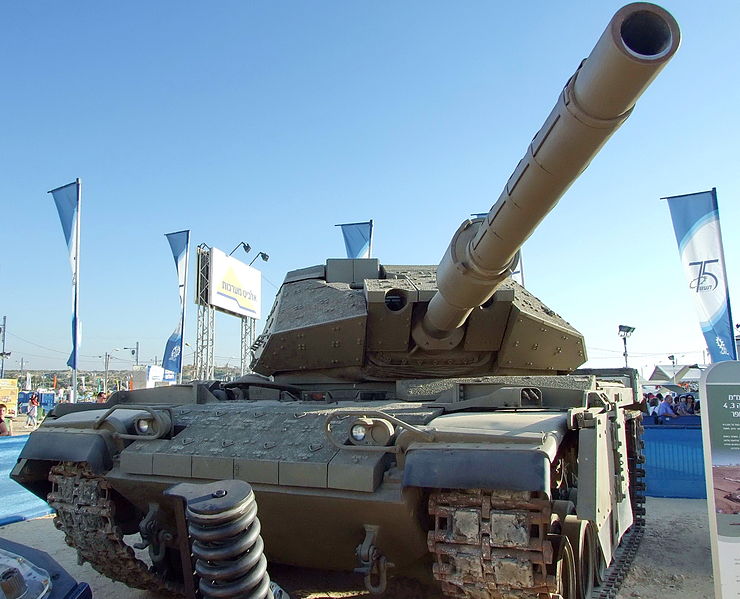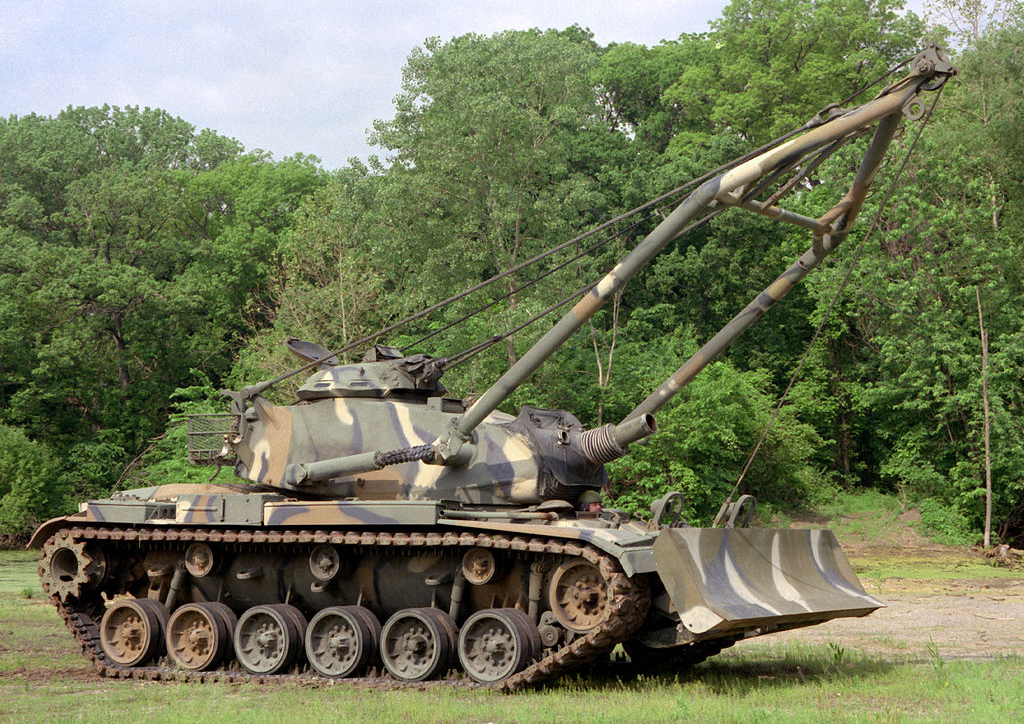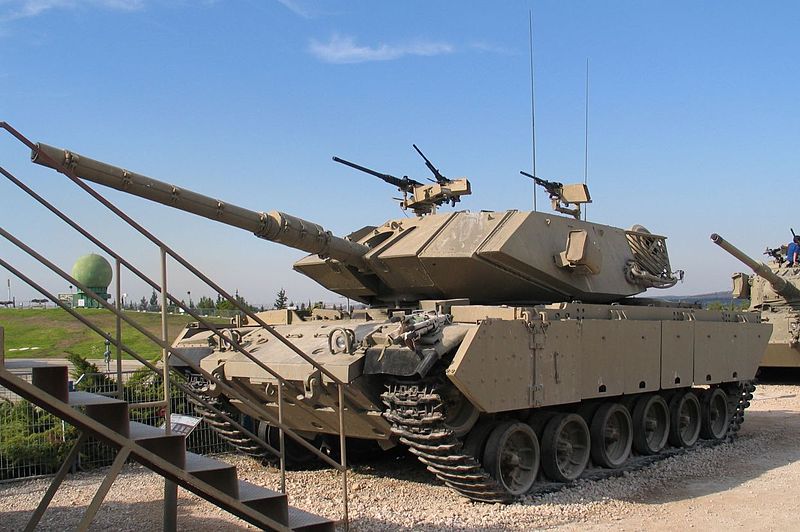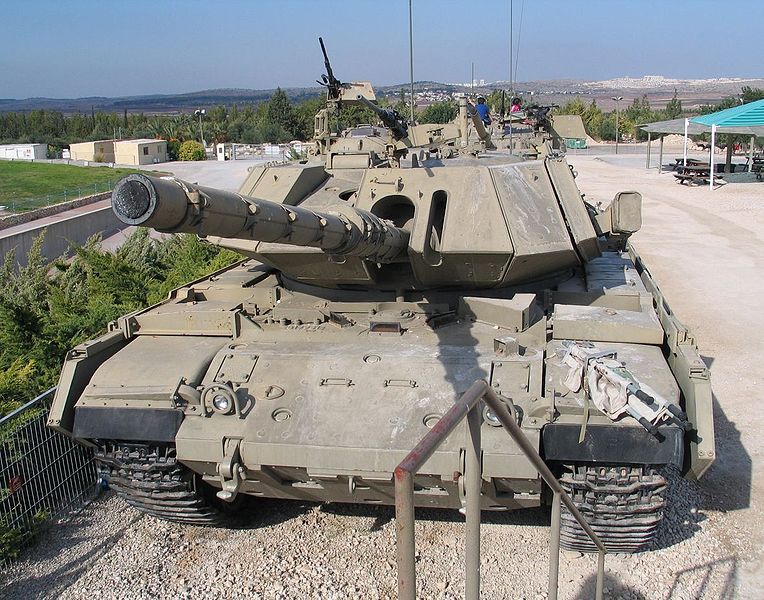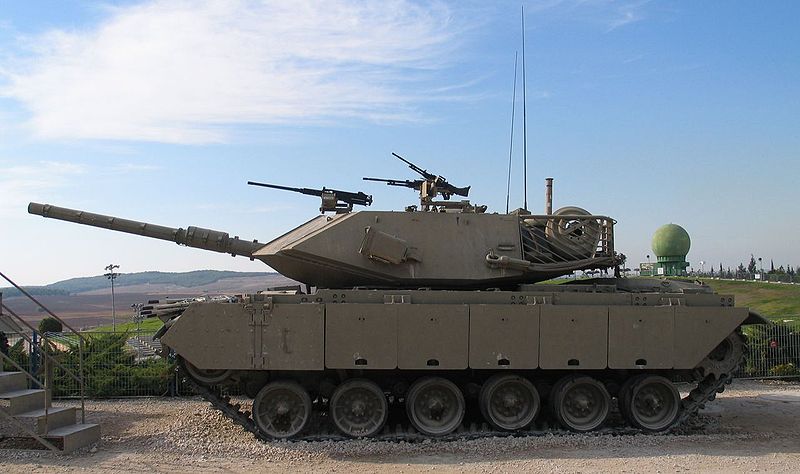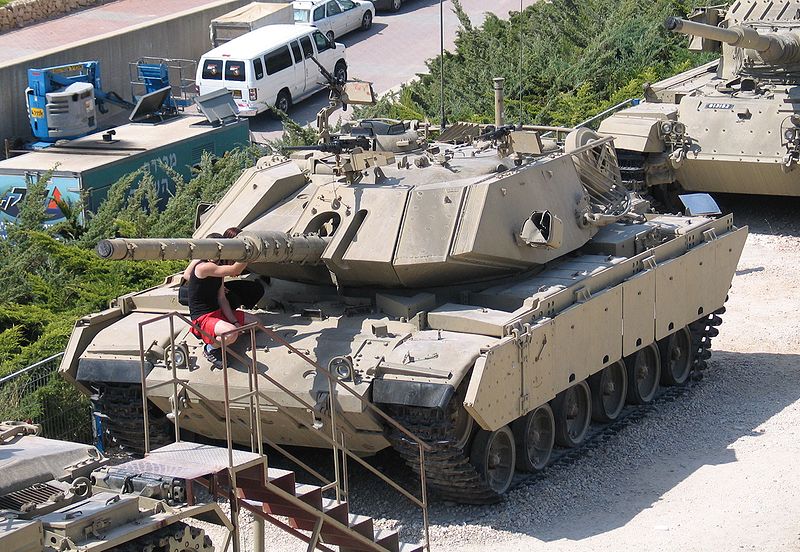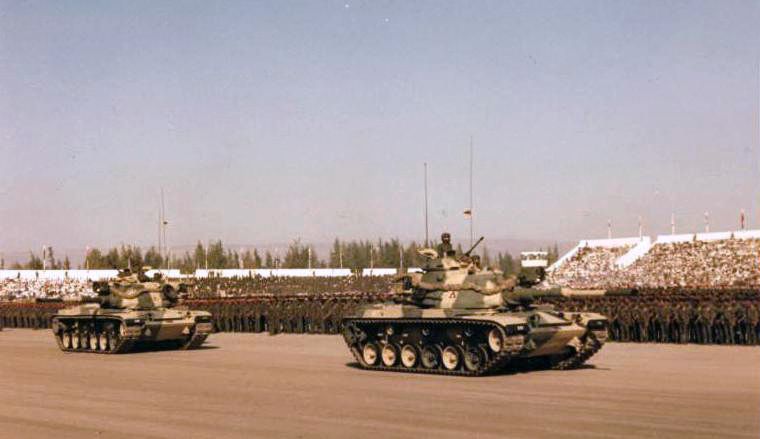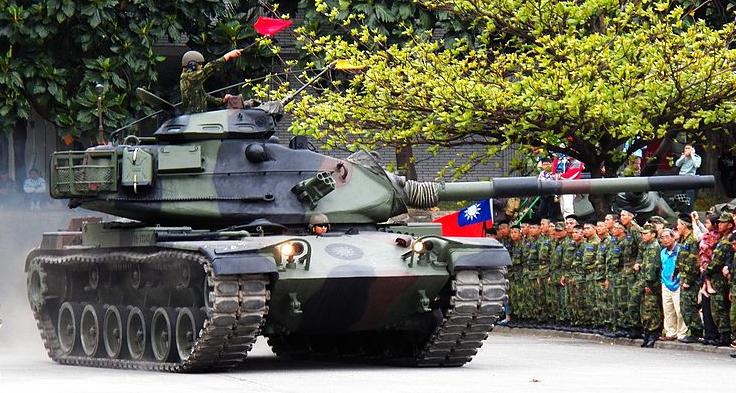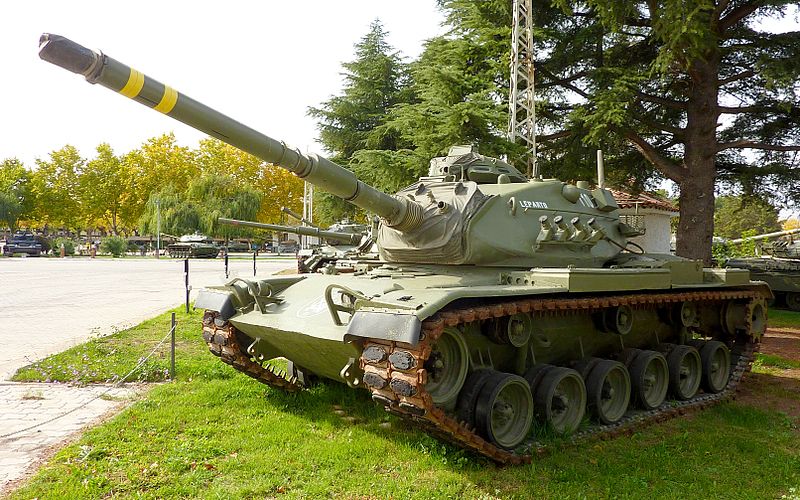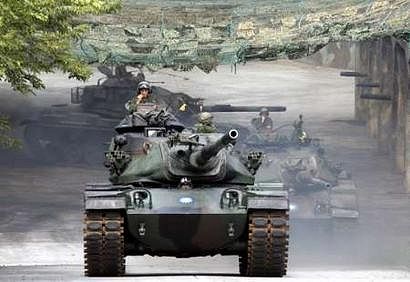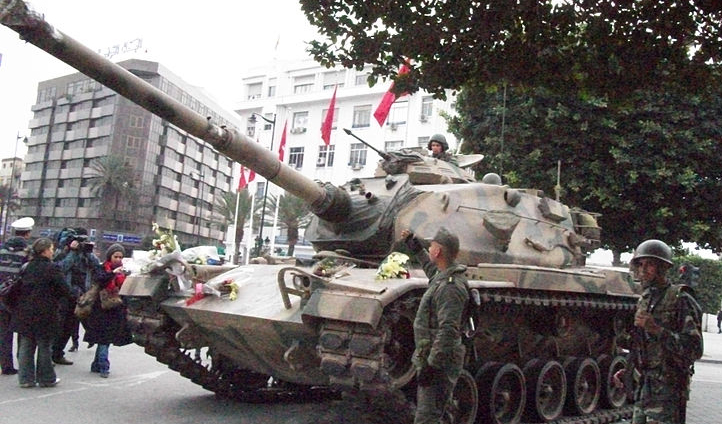A logical evolution of the M48
The M60 looks, at first glance, very much like the M48 designed five years earlier, and for good reasons. It was nothing more than an evolution of the type but modified too extensively in too many ways to be considered by the US Ordnance a simple version of the latter. The OTCM (Ordnance Technical Committee Minutes) #37002 officially standardized the type as the 105 mm Gun Full Tracked Combat Tank M60. It was not officially named “Patton”, but it was the first officially named as a “main battle tank”, and not a medium tank. For three decades, the M60 was the workhorse of the US Army, USMC, NATO’s and Allied or affiliated nations to the western block around the world.
With more than 15,000 built over a large period of time, modernized in various ways, it was still in service in the US in 1997 and is still frontline with many armies in the world today, a testimony to the soundness of the original design. Although considered very much like a 1st generation MBT, it was modernized as a 2nd generation MBT, on par with its European counterparts of the sixties, the British Chieftain, German Leopard and French AMX-30. Now it is retired from US service, but some specialized variants are still active.
M60 characteristics
In a general way, the M60 is very much an upgraded M48 and had the same issues and advantages which kept it in service for such a long period of time, even long surviving the introduction of the more advanced M1 Abrams. The M60 was criticized for its high profile and lack of cross-country mobility compared to European models, but it was also roomy and comfortable, proving time and time again its extraordinary aptitude to be upgraded, as well as its reliability and ruggedness.
Development history
The M60 mostly owes its existence to a singular event, the capture of Soviet T-54A, driven onto the British Embassy gardens at Budapest during the 1956 Hungarian revolution. It was recovered and sent to NATO’s top brass and experts. Live ammunition firing tests showed not only that this tank could withstand the British 20 pounder of the Centurion or the American 90 mm (3.54 in) of the M47 and the new M48 Patton. Therefore, the Royal Ordnance L7 was quickly designed and became NATO’s standard tank gun for years.
The British decided that all future modernization and new tanks will be based on it, leading to discussions between Germany, Italy and France for a future “Europanzer”, which would also use the gun. In the USA it was decided to adopt the gun for mass production under license. A new platform was quickly designed around the new M68 tank gun, largely based on the M48A3. It was to be named M68 (like the cannon) in 1959 when the first prototype was tried, but the Ordnance Bureau renamed it the M60, according to the year of acceptance. In 1963, the initial model was replaced by the M60A1, which would be the production standard until 1980.
M60 Patton design
Hull
Studies for a better-protected tank with a 105 mm (4.13 in) gun started in 1957. At first, the hull was a one piece steel casting divided into three compartments, with a straight front slope and beak (the M48 had a rounded one). However, the bottom hull was still “boat-like”, with a pronounced recess between the upper tracks and external suspension arms. The armor was improved, at 6 inches (155 mm) on the front glacis and mantlet of solid rolled homogeneous armor, while it was 4.3 inches (110 mm) on the M48. The M60 was the last American tank using this RHA, 1st gen. tank armor formula. Despite the added weight of the engine, armor and new gun, the tank was only two ton heavier, at 50.7 tons versus 48.5 tons of the M48A1. The driver sat in the middle of the flat portion after the glacis slope and had three day periscopes. The central one would be replaced by an infrared vision device. He had an escape hatch under the hull, in case of an evacuation if the gun would block the upper hatch. His own access to the turret was restricted, as the turret needed to be turned backward.
Armor scheme progression by version/ degrees of inclination (version) *equivalent of RHA.
- Gun mantlet: 114 mm/60 *131 mm (M60), 130 mm/30 *260 mm (A1), *292 mm (A2), 130 mm/30 *260 mm (A3)
- Turret face: 178 mm/55 *217 mm (M60), 208 mm/55 *254 mm (A1), *292 mm (A2), 208 mm/55 *284 mm (A3)
- Turret sides: 76 mm/55 *92 mm (M60), 115 mm/55 *140 mm (A1), 121 mm/90 *121 (A2), 115 mm/55 *140 mm (A3)
- Turret bustle: 51 mm/80 *92 mm (M60), 58 mm/80 *66 mm (A1), 64 mm/80 *73 mm (A2), 58 mm/80 *66 mm (A3)
- Turret Roof: 24 mm/0 *24 mm (M60), 25 mm/0 *25 mm (A1), 31 mm/0 *31 mm (A2), 25 mm/0 *25 mm (A3)
- Hull glacis: 93 mm/25 *225 mm (M60), 109 mm/25 *257 mm (A1, A2, A3)
- Hull beak: 85 mm/35 *131 mm (M60), 143 mm/35 *249 mm (M60A1, A2, A3)
- Hull sides: 74 mm/90 *74 mm (M60, A1, A2, A3)
- Hull rear: 41 mm/60 *47 mm (M60, A1, A2, A3)
- Rear engine bulkhead: 30 mm/30 *60 mm (M60, A1, A2, A3)
- Fighting Comp. Floor: 19 mm/0 *19 mm (M60, A1, A2, A3)
- Engine comp. Floor: 13 mm/0 *13 mm (M60, A1, A2, A3)
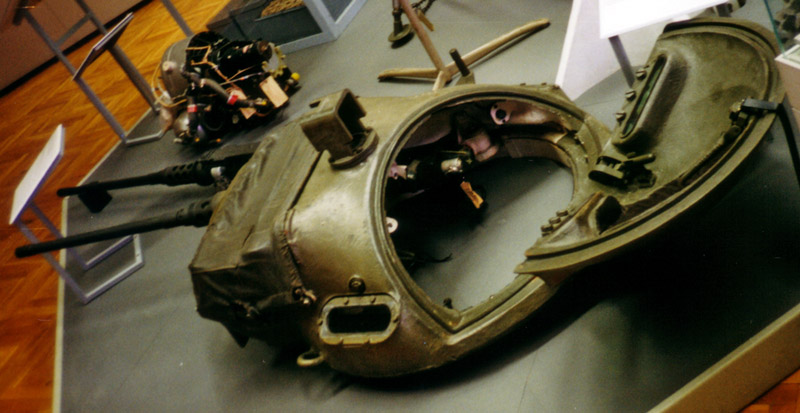
M48 Commander cupola close view
Turret
The turret was still the clamshell-shaped M48 turret on the M60, but it was changed in 1963 to the distinctive “needle nose” design of the M60A1, which made for a narrower front cross-section, minimizing the surface offered to enemy fire. This allowed optimizing the layout of the combat compartment, as this turret was more elongated and significantly roomier, for the same central width. The earlier production M60s did not have any commander cupola. It was added in the form of a heavy commander cupola/heavy machine-gun turret, with the hatch on top. This particular arrangement, which reminds of the old M3 Lee, allowed the commander to operate the cal.50 (12.7 mm) machine-gun from inside, fully protected (see later). Although provisions for additional pintle mounts were made, the main auxiliary weapon of the tank was this HMG. The coaxial cal.30 (7.62 mm) M73 acted as much as a targeting device as an anti-personal close defense system. The arrangement was typical of US tanks of the time, with the gunner on the front right and the commander right behind him, while the loader was on the left-rear hand side.
The turret roof was characterized by this massive “secondary turret” on the turret’s right, which counted a beak mantlet at the front with the main periscopic sight above, a one-piece, hinged at the top-rear hatch in the middle, and six vision blocks with bulletproof glass on the sides and rear. Three welded handles allowed this turret-cupola to be lifted for repairs and maintenance. This was dictated by NBC measures as well as for the tank commander’s protection when firing his weapon and especially in an urban environment. Compared to the M48 similarly-arranged turrets featuring the classical “Ma Deuce” cal.50 (12.7 mm), the M60 cupola was given the M85, a revised 12.7 mm (0.5 in) derived from the M2HB HMG, but modified for AA defense. Thanks to the much more compact dimensions and being horizontally-fed, the M85 could fit more easily inside the cramped cupola forward space.
But experience showed that due to this tight fit and excessive vibrations, the mounts had tendencies to break up. It was also a high, obvious target, but provided much better protection than the M48 cupolas, as shown by the injuries reports. Tanks commander could better brace themselves during brutal cross-country maneuvers. At the end of the production, on the M60A3, the design reverted to a lower, more conventional “Urdan” type (Israeli influenced) cupola. The next M1 Abrams also eliminated this feature to revert to a lower profile. The single-piece, hinging backward loader’s hatch was located on the left-hand side on the roof. A mushroom-shaped fume extractor took place at the rear left of the turret bustle.
Armament
The firepower is provided by a bore evacuated 105 mm (4.1 in), 52 caliber M68 rifled tank gun derived from the British Royal Ordnance L7. A real improvement over the previous 90 mm (3.54 in), it gave almost twice the range, with much greater accuracy and far better muzzle velocity. It is characterized by its 1/3 down length placed bore evacuator with a specific eccentrically mounted extractor and an American vertical sliding breech block. Not only the gun could share standard NATO ammunition of the HE, Frag, AP, HEAT types, but it could be replaced by foreign-supplied models if needed in combat conditions, because of its full compatibility. It could fire at an average of 10 rounds per minute (maximum) with a well-trained crew.
The M68 was standard until the mid-1980s when the M1 Abrams swapped it for a 120 mm (4.72 in). It was complemented by a coaxial M73 0.3 cal. (7.62 mm) machine gun and an M85 cal.50 (12.7 mm) took place on the roof, inside the commander cupola’s smaller turret, which allowed him to fire while being protected. Round storage was distributed between the turret bustle, a few ready rounds of various types were fastened and accessible for the gunner, and the rest was stored inside safe containers on the hull floor. The M60A2 introduced a 152 mm (6 in) missile gun.
Types of ammunition used by the M60 (from the M60 to the M60A3)
- APDS-T : M392, M392A2, M728
- HEP-T : M393, M393A2
- HEP TP-T : M393A1
- SMOKE, WP-T : M416
- HEAT-T : M456, M456A2
- Dummy : M457
- HEP TP-T : M467
- HEAT-TP : TM490, TM490A1
- APERS-T : M494
- TPDS-T : M724, M724A1
- TPCSDS-T : DM128
- APFSDS-T : M735, M735A1, M774, M833, M900
Engine
The engine was a Continental AVDS-1790-2 V12, air-cooled twin-turbo diesel engine, which provided 750 bhp (560 kW), giving a power to weight ratio of 15.08 bhp/t, compared to the 810 hp gasoline engine of the first M48 version. This change was required after seeing the M48 plagued by its short range in operations. The diesel almost doubled the operational range, and to put it like the American tankers of the 1960s did, “now the army has legs”. This new power unit was served by a single-stage, cross-drive Allison CD-850-6 transmission, combined with differential steering with 2 forward and 1 reverse ranges, and braking unit. This powerpack was reliable and, although not giving tremendous speeds, nor cross-country mobility prowess, was appreciated by the drivers for its ride smoothness.
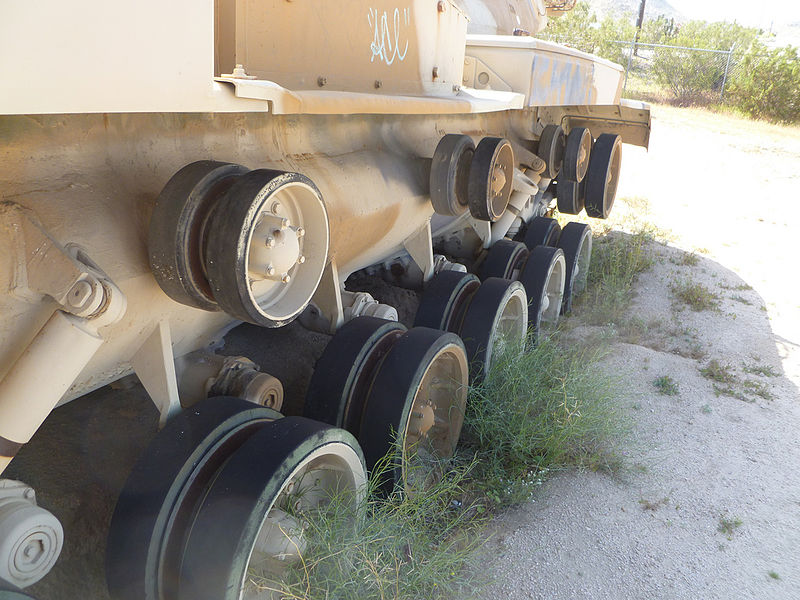
Closeview of the M60 running gear.
Drivetrain
The drivetrain was identical to the one on the M48 with one exception, it counted only three return rollers, versus five on the M48, and the roadwheels were cast in aluminum, and not in steel, a weight-saving measure. However, this made them slightly more fragile, and costlier, so spare steel roadwheels were kept. There were six paired roadwheels on each side, for a total of 24, all rubberized. The front idler was an un-ruberrized roadwheel pair. The back drive sprocket were identical to the standard model. The tracks were also identical and equipped with rubber shoes.
The M60A1 (1962)
This was the first major version and mass-production model, characterized by a new “needle nose” turret. The latter was not adopted immediately, and a significant number still fielded the M48A3 turret. It was in service since the spring of 1962. As it was at least two tons heavier, this forced the adoption of a shock absorber on the second roadwheel pair and was also accompanied by a slight relocation of the first return roller.
The Continental engine was now the AVDS-1790-2C, served by the Allison CD-850-6A powershift cross-drive transmission. Other minor internal modifications were made to the hull. Early M60A1s had no gun stabilization system. An AOS or add-on-stabilizer was retrofitted in the early 1970s, enhancing first hit killing rate by keeping the gun close to the aim while on the move.
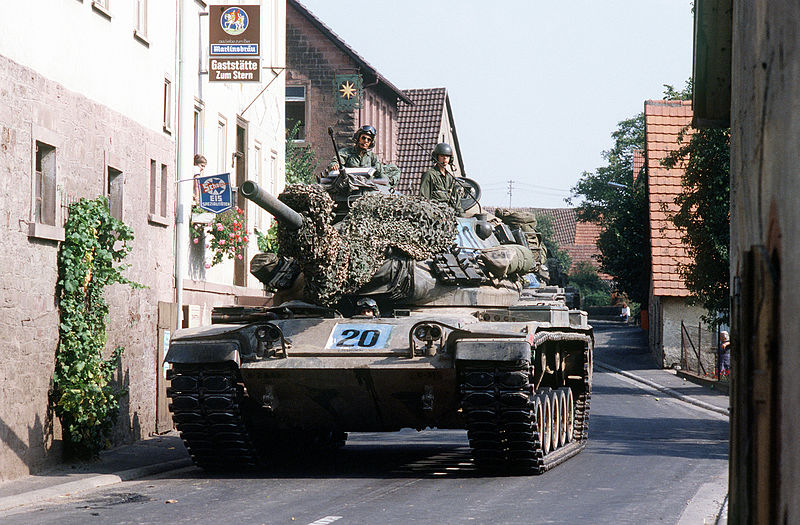
M60A1 in a German village, Operation REFORGER, 1982
Protection was improved (thanks to reports from the 1973 war) with the adoption of add-on chin armor for the turret. In the engine, a new hydraulic fluid prevented the danger of internal fire by lowering the point of ignition. In 1974 and 1975, these tanks were upgraded with RISE (Reliability Improvement of Selected Equipment), consisting in a new engine configuration, and in 1977, the RISE/passive appeared. It consisted in the adoption of passive IR sights for the driver, gunner and commander. The need for a massive IR illuminator above the gun was therefore eliminated. In 1978-79, a battery of two smoke dischargers banks was fitted on either side of the turret. The M60A1 was also retrofitted with the M60A3 T142 tracks with replaceable trackpads. But by the 1980s, after these upgrades, the M60A1 was only distinguished from the M60A3 by its lack of crosswind sensor, armored flap of the TTS and thermal shroud for the main gun. These tanks formed the backbone of the US armored forces until the M1 Abrams became operational. At 58 tons, the late A1 was much heavier than the M60 (50.7 tons), or the early A1 (52-54 tons), thus reducing its mobility.
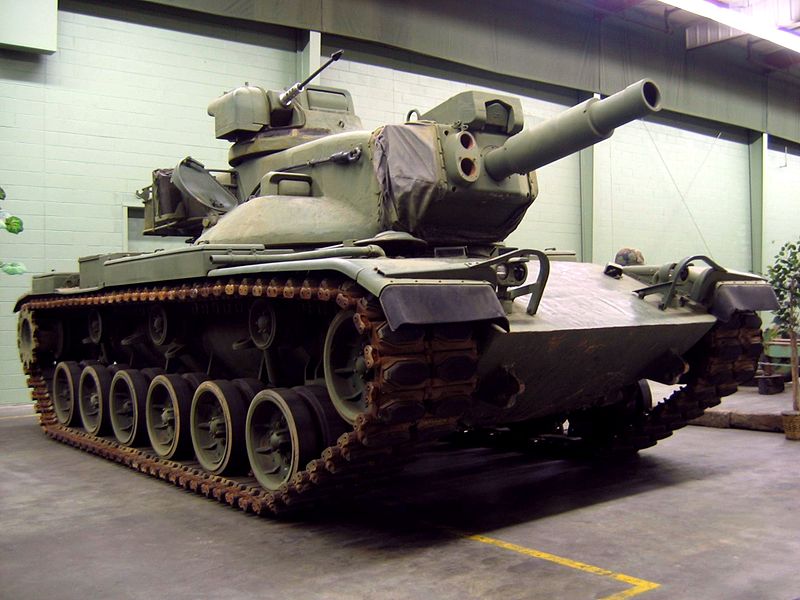
M60A2 “Starship” at the US Army Air Force museum
The M60A2 “Starship” (1969)
In 1966 General Dynamics Land Systems designed a new low profile turret, equipped with a 152mm Gun/Missile Launch system. The new turret was mated to a Medium Tank M60 Patton hull, creating the M60A2, unofficially nicknamed the “Starship”. Though the vehicle was one the most technologically complex of its era, this also contributed to its failure, largely due to difficulties with maintenance, training, and complicated operation.
The M60A3 (1980)
Work on a vastly enhanced version began in 1978, at the same time the M1 Abrams program began. This was chiefly to keep the M60 in operation alongside the much costlier new main battle tank, and to be able to face off the T-64 and T-72. Although the hull and turret remained unchanged for the most, it was easily distinguished by the fitting of two banks of smoke dischargers, an AN/VVG-2 flash-lamp pumped ruby-laser based rangefinder, an M21 ballistic computer and a turret stabilization system. At mid-production, it was also decided to delete the cupola.
This was done for three reasons. Israeli studies on their own M60A2/A3s in combat (IDF tactical doctrine imposed that the commander fight unbuttoned, exposed) showed that a non-penetrating hit on the turret roof, burying itself at the base of the cupola (acting as a shot trap) could dislodge it, instantly killing the commander. In addition, the locking mechanism of the hatch was dangerous to use under fire. The performances of the remote-controlled M85 heavy AA MG as originally intended were even worse than those of the pintle-mount cal.50 (12.7 mm), due to limited elevation. Therefore, late versions are recognized by their low-profile, simpler “Urdan cupola”, and the overall silhouette of the tank was greatly diminished in the process.
The service duration of the M60A3 was impressive, spanning two and a half more decades, from 1980 to 2005. This was due to a number of factors, that made it compare well with the much more advanced M1. The TTS, for example, had better thermal imaging systems, at least until the M1 used the 2nd generation IR system. The infantry telephone on the back plate was still on the M60 but was eliminated on the M1 and later retrofitted with TUSK. Although having lower performance, the M60 engine was much cheaper to maintain, more fuel-efficient and had also a lower temperature.
It was, therefore, less dangerous for infantry marching behind. The floor escape hatch, absent on the M1, was also an added safety feature for the crew, if the tank was turned over or under enemy fire. The 105 mm (4.13 in) main gun could fire a much wider variety of ammunition that the M1, restricted to the APFSDS/HEAT only. Indirect fire was also easier on the M60 and allowed a more variety of operations in coordination with infantry. So, in tactical doctrine, the M1/M60 rôles were refined and well distributed. The M1 Abrams was to spearhead the armored assault and deal with enemy tanks, while the M60 was to follow with infantry to clear and sanitize the area, especially in an urban environment. However, both tanks were equally sensitive to IEDs.
M60 Patton links & resources
The M60 Patton on Wikipedia
On Patton-Mania
On Military-factory
M60 Patton equipped with a mine plough on training at the Quantico USMC base.
Variants
- The M60A1 AOS: Stabilization of the M68 gun introduced in 1972.
- M60A1 RISE: (Reliability Improvements for Selected Equipment). Upgraded engine design for easier access and removal and sturdier T142 track type.
- M60A1 RISE Passive: Smaller infra-red/white capable search-light and passive night vision devices. ERA was added in the late 1980s.
- M60A1E1: The experimental prototype which tested a new turret for the 152 mm (6 in) M162 cannon. Led to the M60A1E2, then M60A2 “Starship”.
- M60A1E3/E4 prototypes with a new 150 mm (5.9 in) gun and remote-controlled weaponry.
- M60A3 TTS: Fitted with upgraded AN/VSG-2 thermal sights.
- M60 super/AX: Featured additional protection.
- M60-2000 120S: A hybrid with M1 Abrams gun and electronics, tested, but not adopted.
- M60 AVLB: The scissor-stype 60 feet (18 m) span bridgelayer, later upgraded on the M60A1.
- M60 AVLM: Armored Vehicle Launched MICLIC (Mine-Clearing Line Charge).
- M60 Panther: Remotelly-operated mine-clearing tank.
- M728 CEV: Combat engineers version, featuring a A-frame crane and winch, M135 165 mm (6.5 in) demolition gun, mine plough or bulldozer blade.
- M9: Dozer blade kit for the M60.
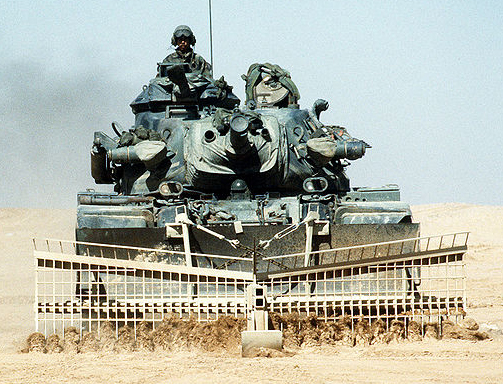
M728 Combat Engineering vehicle with mine rake.
Worldwide exports
The M60 was kept for US service alone (although some were sent to Israel), whereas the M60A1 was supplied to U.S. allies, like Austria and Italy in Europe, Iran, Israel, and Jordan in the Middle East. The M60 is still used by the USAF for testing purposes. The M728 Combat Engineer Vehicle and the M60AVLB are also still in service.
Austria
The Austrian M60A1s were rebuilt to the A3 standard by Steyr-Daimler-Puch in Austria. In the 1990s they were sold to Egypt.
Bahrain
This country operates some sixty M60A3 to this day.
Bosnia-Herzegovina
Eighty-five M60A3s were delivered in 2012. They are still in service.
Brazil
Ninety-one M60A3 TTS were purchased. They are in service today.
Egypt
This is currently the biggest user of this model, with 1016 M60A3s and 700 M60A1s.
Ethiopia
The Ethiopian army purchased an unknown number of M60 or M60A1.
Greece
The Greek army received 357 M60A1 RISE Passive and 312 M60A3 TTS MBTs. They are now retired.
Israël
The Israeli defense force operates some 711 Magach 6 Archuv and Magach 6 Archuv 2, and 111 Magach 7 as of today. They received extensive protection with ERA or passive armor. Older models were known as the E60 (M60), E60A (M60A1), and E60B (M60A3).
Israel also developed the M60 Sabra and the M60T or Sabra Mk.II. This is a highly upgraded M60A1 developed for the Turkish Army, with a new 120 mm (4.72 in) smoothbore gun, electric stabilization system, new FCS, and upgraded armor package.
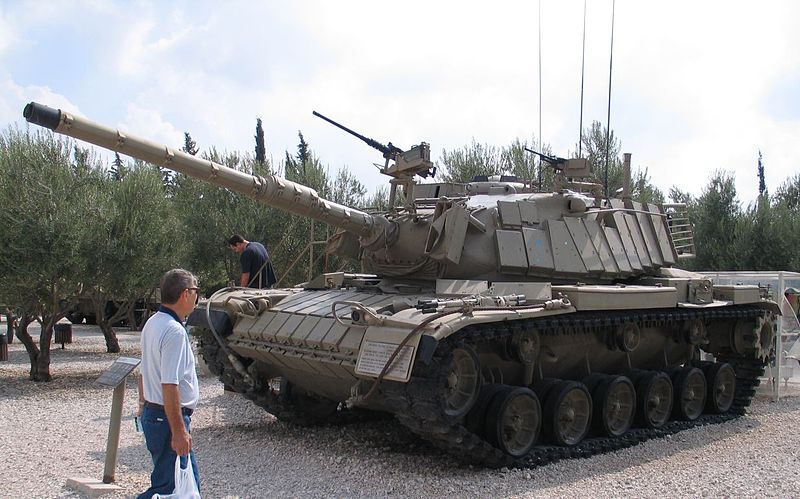 IDF E60A Patton Blazer ERA at Latrun.
IDF E60A Patton Blazer ERA at Latrun.
Italy
Italy produced 200 M60A1s under license at OTO Melara, and received 100 more, for a total of 300 in the 1970s. They are no longer in service.
Iran
This country operates some 150 M60A1(as of 2010). In 1961, the first delivered defected, crossed the border, and was captured and studied by USSR. As of today, these tanks are in the process of being upgraded to the Samsan (Sword) standard. Locally developed, with some help from Russia, it includes ERA (Kontakt-5) protection, an EFCS-3 fire control system, a laser warning system and IR jammers.
Jordan
The Jordanian kingdom operates 182 M60A3s. The King Abdullah II Design And Development Bureau developed the Phoenix, a radical local upgrade which includes a 120 mm (4.72 in) RUAG smoothbore gun, shoot-on-move capability, and improved protection with ERA and side skirts. The number of conversions is unknown.
Lebanon
About 66 M60A3s were purchased in 2008, the first batch of ten was received on May 22, 2009.
Morocco
The Moroccan army operates a total of 260 M60A3TTS and 167 M60A3.
Oman
The Omani army operates some 93 M60A3 tanks as of today.
Saudi Arabia
The Saudi Royal Army operates some 450 M60A1 and M60A3 as of today.
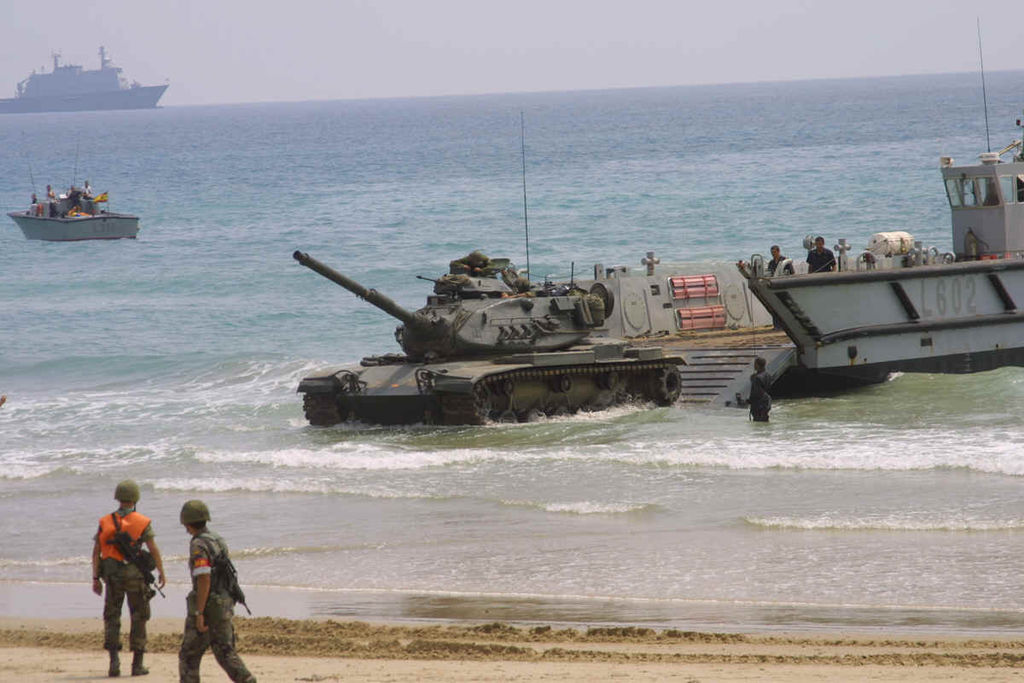
Spanish Marines M60A3 TTS landing off during exercises.
Spain
The Fuerzas Armadas Españolas received, in early 1990, around 300 M60A3 & A3 TTS (16 of them for the Marines) from Central Europe, according to the Treaty on Conventional Armed Forces in Europe (FACE), and 50 of the A1 version. However, the latter were worn out and did not have the spare parts required. It was thought off applying the modernization program developed for the AMX-30E2 with a Hughes/ENOSA Mk.9A/D imager and FCS, MTU 833 diesel and ZF LSG 3000 transmission, but the perspective to acquire the Leopard II led to the cancellation of this project. The Fuerzas Armadas Españolas today use 16 M60A3TTS for the Marines (Infantería de Marina), 38 modified M60CZ-10/25E Alacran (combat engineer variant), and 12 specialized M60VLPD-26/70E (converted bridgelayer with the “Leguan bridge system”).
Portugal
Fourteen M60A3TTS are in service today. In addition, six M60A2 had their turrets for training.
Republic of China
The Taiwanese army operates some 450 M60A3 TTS as of today.
Thailand
The Thai army has some 178 M60A1 and M60A3 in service, obtained from the U.S. Army
Tunisia
The Tunisian Army operates some 59 M60A3 and 30 M60A1.
Turkey
The second-largest user of the type (after Egypt), operates some 658x M60A3 TTS, 104x M60A1 RISE, and 170x M60A1 specialized variant the Sabra. The Israeli Military Industries won a contract in March 2002 to upgrade 170 Turkish Army M60A1 tanks with the installation of a new 120mm smoothbore gun, Elbit Systems’ electric gun and turret drive stabilization system, including a new fire-control system and a new armor package. These upgraded M60A1 main battle tanks are also known as the Sabra MkIII upgrade. Turkish Army M60A3 tanks were deployed inside Syria after rockets were fired over the border in August 2016.
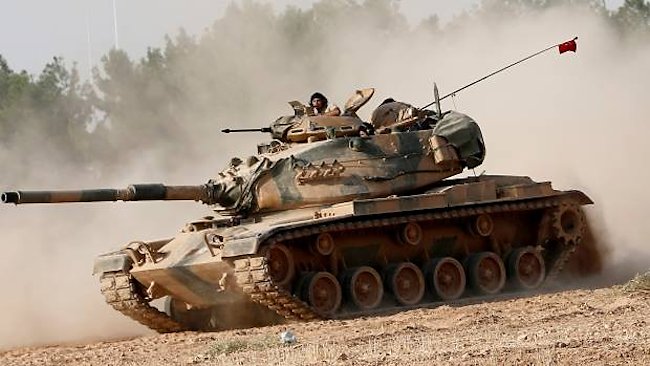
Turkish Army M60A3 tank
Yemen
The Yemeni Army operates some 240 M60A1 or A3. No other details could found.
The M60 Patton in action
Due to an impressive service length span, the M60 and variants participated in some major conflicts and many operations. The most important such battle theatre also saw the most number of M60 of many nations engaged, within the coalition forces in 1991 (Operation Desert Storm).
In US service, the M60 never saw service in Viet-nâm, contrary to the M48. For the US Army, the only operations were at Grenada (1982), Beirut (1983), and the Gulf War (1991). In the mid-1980s, close air support trials took place along with ground-combat equipped F-16s and pioneered tactical doctrines and technologies later used with M1 Abrams-equipped units. These occurred notably at the Red Flag exercise at Nellis AFB Nevada. After the end of the Cold War, most of the M60s (which were USMC M60A3s) were placed in reserve and only specialized variants were kept in service, like the M728 Combat Engineer vehicle and the bridgelayer version AVLB.
Yom Kippur War (1973)
The M60 was first blooded during this war opposing Israel to Egypt, Syria and Jordan. About 150 M60A1 (E60A) were opposed, with success, to the Egyptian-operated T-54/55 and T-62. But, at the same time, in the Bar-Lev line, they were destroyed in rows by Egyptian-manned portable AT-3 Sagger shaped-charge missiles, following the Egyptian crossing of the Suez Canal. Due to their effective gun, mobility and excellent safety records, IDF M60s had been highly regarded and were upgraded significantly, leading to the Magach 6/7 types and the Sabra for the export market. During this conflict, Jordan also possessed M60A1, but none was deployed.
Iran–Iraq War (1982-89)
The Iranian M60s were seriously tested against Iraqi T-55, T-62 and T-72s, and performed well alongside some M48s. Before the revolution, Iran had some 350 M60A1s, but this number dwindled rapidly due to the lack of maintenance and spare parts, to the actual figure of 150 tanks in 2011. At least one M60 was captured by Iraqi troops, evaluated, and was found in Baghdad in 2003.
Lebanon War (1982)
The Israeli Magach 6 formed the core of the armored forces involved in Operation Peace in Galilee, dealing with Syrian T-54/55 and T-72s or even ex-PLO T-34/85s. The only loses occurred when encountering Syrian infantry hunter-killer teams using ATGMs, RPG-7s and SA-7 Grail MANPADs. HOT missiles fired from Syrian Gazelle helicopters were also deadly. A single M60 was damaged, evacuated by its crew and shipped back to Syria to be studied by Soviet technicians, which gave them clues about the latest NATO ammunition on board. It is now still on display in Damascus.
First Gulf war (1991)
During Operation Desert Storm in February 1991, USMC’s M60A1 ERA rolled into Kuwait City after a fierce battle at the Kuwait Airport. Some 200 participated in the largest tank battle for an USMC unit since World War Two, dealing with Iraqi T-54/55, Type 69, and T-72 tanks, north from Khafji. This unit claimed nine dozen Iraqi tanks destroyed for a single M60A3 lost.
At the same time, USAF 401st TFW (P) unit used M60s based in Doha AFB, Qatar, modified to deal with unexploded ordnance from tarmac runway and taxiway surfaces. Saudi, Egyptian and Omani forces also deployed their own M60s in this operation.
Operations in Afghanistan (2002-2012)
Only specialized variants were deployed, having a great deal of activity altogether in several sub-operations at tactical organic unit level, notably to create provisional bases and depots.
M60 Patton Gallery
M-60A1 specifications | |
| Dimensions (L-W-H) | 30’9″ (22’8″ without gun) x 11’9″ x 10’7″ ft.in (9.43m (6.94m) x 3.63m x 3.27m) |
| Total weight, battle ready | 52 tons (114,640 lbs) |
| Crew | 4 (commander, driver, loader, gunner) |
| Propulsion | Continental AVDS-1790-2 V12, AC TT diesel, 750 bhp (560 kW), 15.08 bhp/t |
| Transmission | General Motors, CD SD 2 fw/1 rv ranges |
| Maximum speed | 30 mph (48 km/h) on road |
| Suspensions | Torsion bars suspensions, shock absorbers |
| Range (fuel) | 300 miles/500 km (1457 liters/385 US gal.) |
| Armament | Main: 105 mm (4.1 in) gun M68, 70 rounds Sec: 1 x cal .50 M85 (12.7 mm)+ 1 cal .30 (7.62 mm) Browning M73 |
| Armor | RHA max. 6.125 in (155 mm) |
| Total production (all combined) | +15,000 |
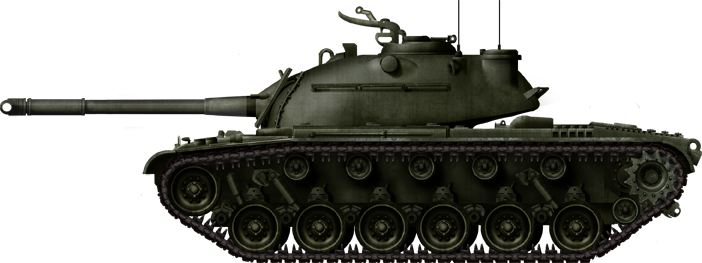
The M48 Patton, for comparison.
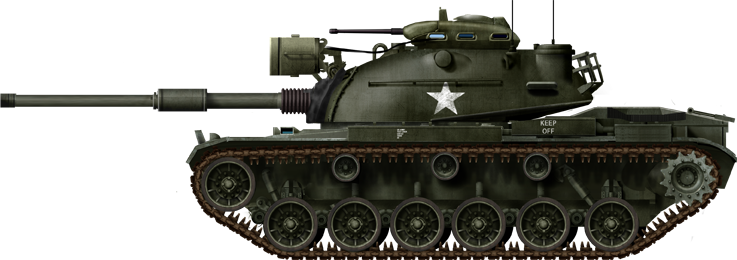
M60 Patton in trial markings, first pre-production run, 1959.
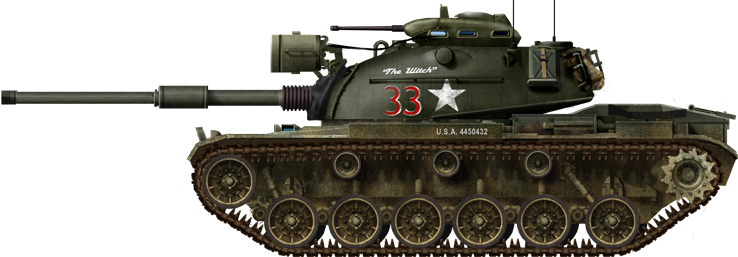
M60 Patton of the main production series in exercises in the 1960s.
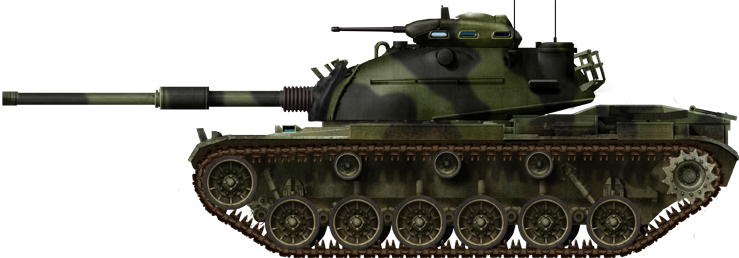
Camouflaged M60 Patton used until the 1990s by the US Reserve or National Guard unit, now preserved at the Fort Lewis Military Museum, Washington.
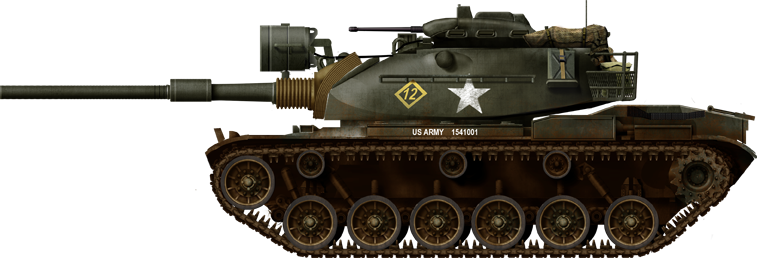
M60A1 Patton, early production version with the aluminium roadwheels, 1963.
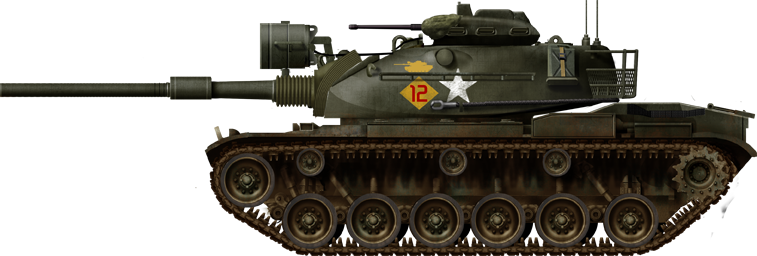
M60A1 Patton with steel roadwheels in drilling exercises, fall 1960s.
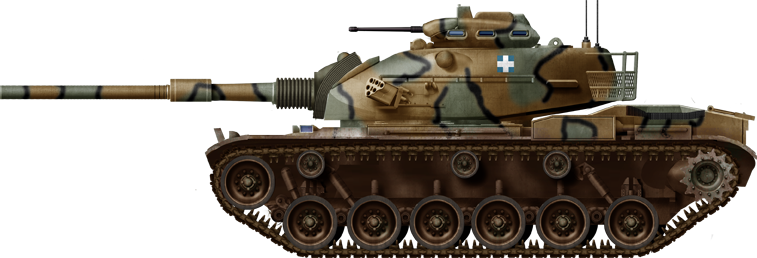
Greek Army M60A1.
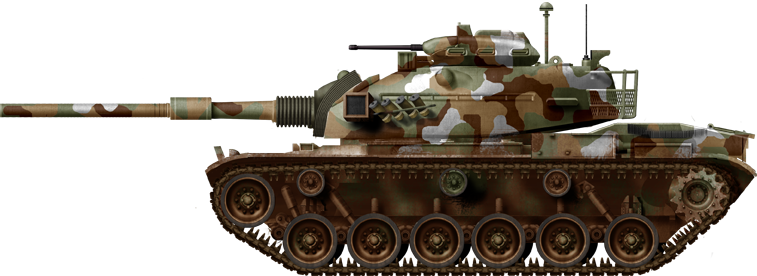
Iranian Samsan (Farsi for sword), locally-developed upgrade of the 1976-78 M60A1.
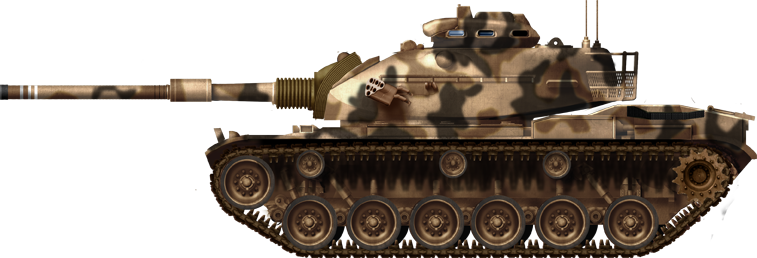
M60A1, apparently used in exercises in the desert in the 1980s.
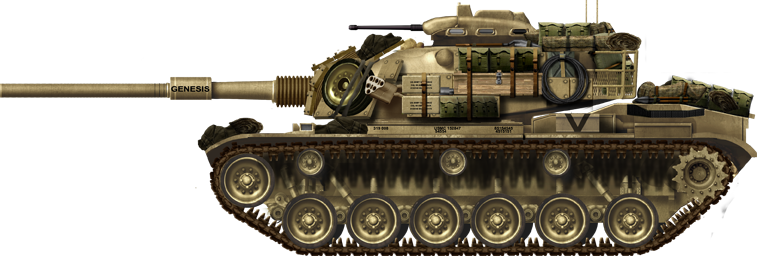
M60A1 ERA of the USMC, battle of Kuwait Airport, February 1991. This was the largest tank battle of the USMC since World War Two.
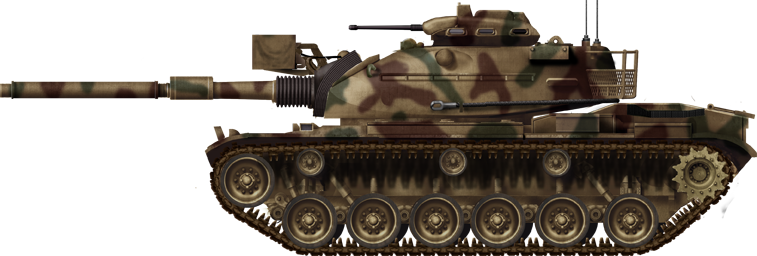
Libyan M60A1 in 2011. Notice the laser range finder and thermal sleeve.
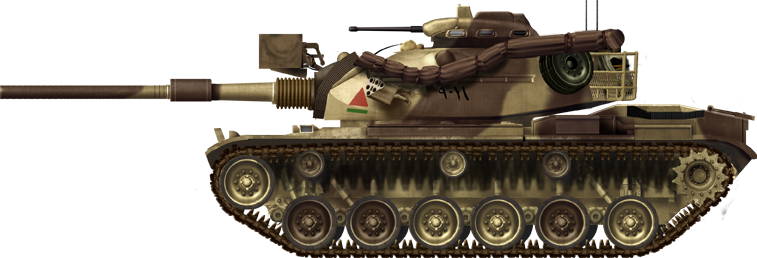
Egyptian M60A1, Operation Bright Star, 1985.
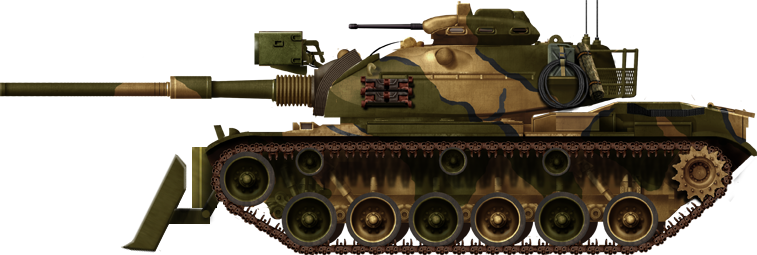
M60A1 RISE in the 1980s.
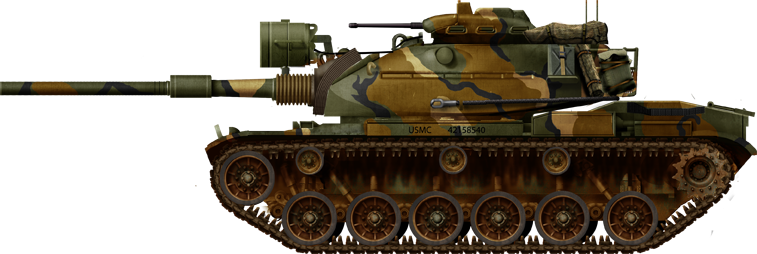
M60A1 of the USMC, 1970s.
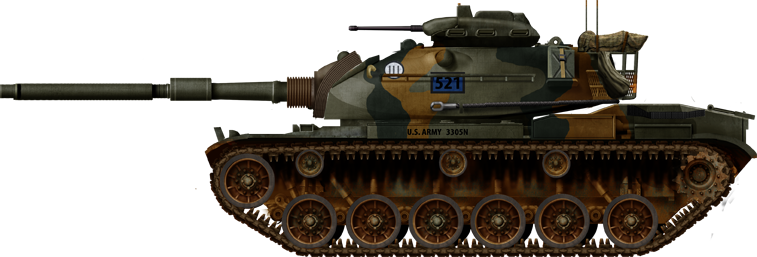
M60A1 of the US Army in the 1970s.
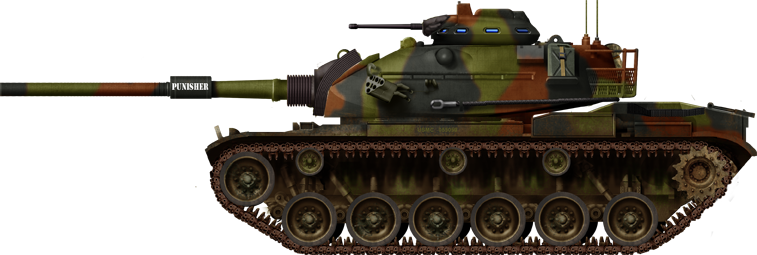
M60A1 Rise TTS.
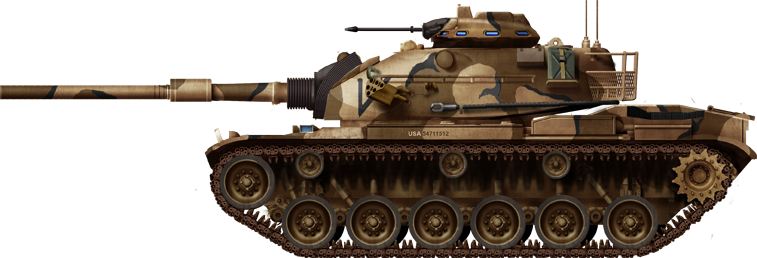
M60A3 RISE US Army Nevada, 1980s.
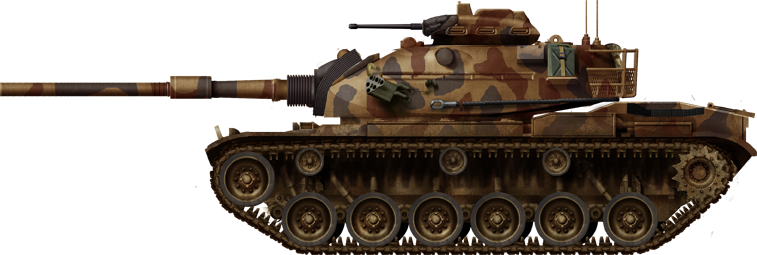
Tunisian M60A3.
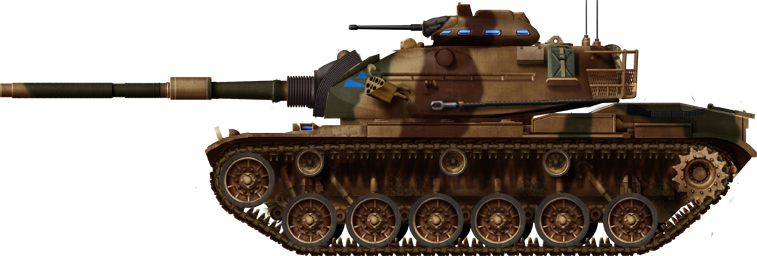
Egyptian M60A3, 1990.
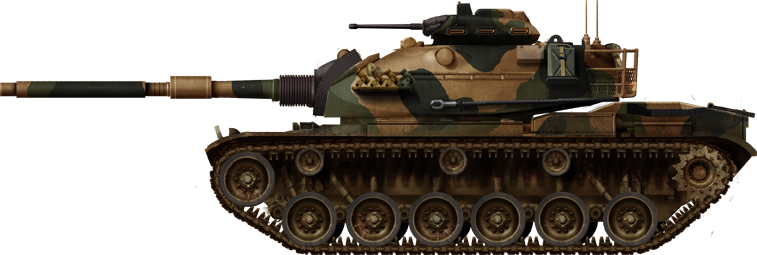
Turkish M60A3 TTS.
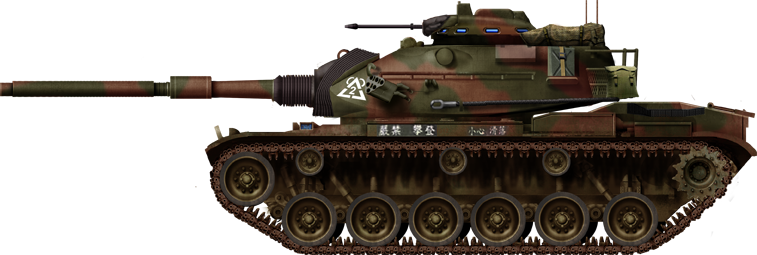
Taiwanese M60A3, during an exercise at the 58th Artillery Command.

Brazilian M60A3.
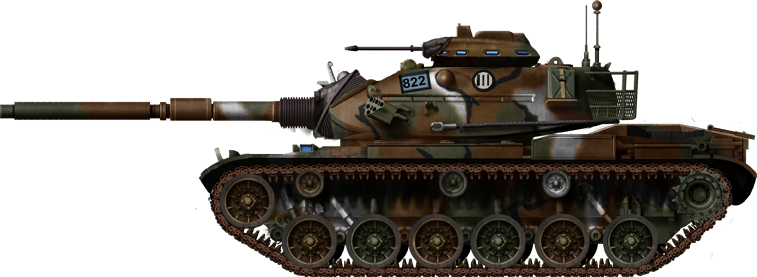
M60A3 Patton, 2/68 Armoured Regiment, 8th Infantry Division, Operation REFORGER 1988, West Germany.
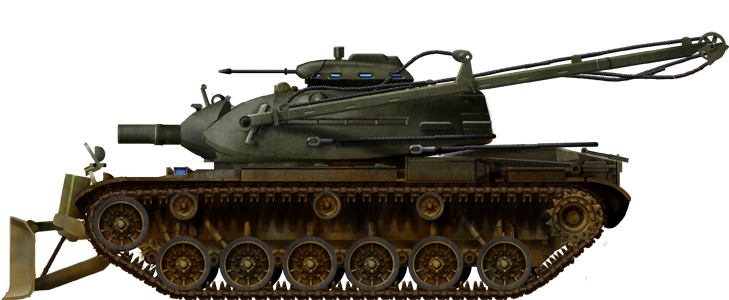
M728 CEV armored recovery & genie vehicle, US Army, late 1970s.
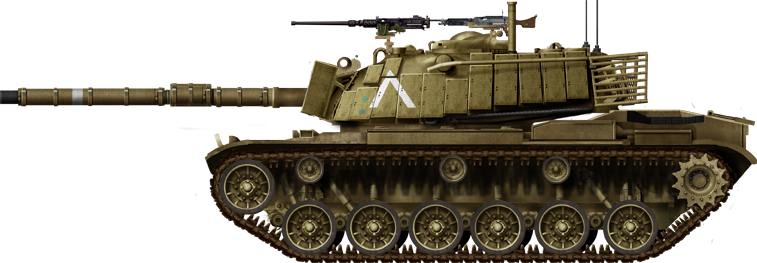
Israeli E60A Blazer ERA, 1990.
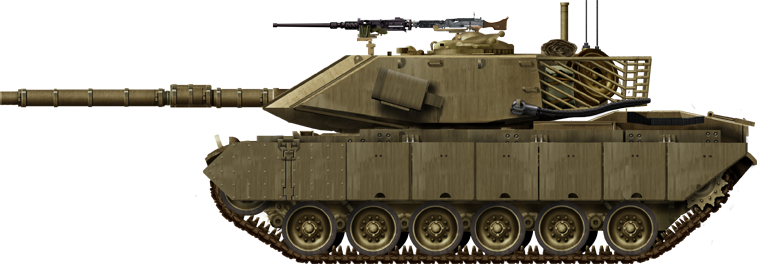
Israeli Magach 7, 1990.

Cold War Tanks


































Cold war tanks posters

Cold War Main Battle Tanks

Cold War Soviet Army
Museums, Movies, Books & Games
The Tanks and Armor in pop culture
Tanks and armored vehicles in general are only really grasped when seen first person: The mass, the scale, it's all there. Explore also the way tanks were covered in the movie industry, in books and in video games.Movies:
Best tanks movie on warhistoryonline.com
On imdb.com
On bestsimilar.com/
miltours.com
liveabout.com/
watchmojo.com
Video Games:
pcgamesn.com
historyhit.com
levvvel.com
vg247.com/best-tank-games
mmobomb.com/
alienwarearena.com


